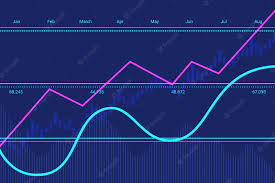Moving averages are statistical indicators that calculate the average price of an asset over a specific period. They smooth out price fluctuations and provide a clearer picture of the underlying trend. Traders and analysts use moving averages to filter the noise and identify significant price movements.
Are you interested in understanding how to analyze price trends in financial markets? One of the most commonly used tools for this purpose is moving averages.
Moving averages help smooth out the price data, allowing traders and investors to identify and interpret trends more effectively. In this article, we will explore the concept of moving averages, their types, and how they can be applied to analyze price trends in various financial instruments.
2. Simple Moving Average (SMA)
The Simple Moving Average (SMA) is the most basic form of moving average. It is calculated by adding up the closing prices of a financial instrument over a specific period and dividing the sum by the number of periods. For example, a 50-day SMA calculates the average closing price of the past 50 days.
3. Exponential Moving Average (EMA)
The Exponential Moving Average (EMA) gives more weight to recent price data than older data points. It assigns a higher weighting factor to the most recent prices, making it more responsive to current market changes. This makes the EMA more suitable for short-term analysis and trend identification.
4. Calculating Moving Averages
Select a period to calculate a moving average and decide on the moving average you want to use (SMA or EMA). Then, sum up the closing prices for the chosen period and divide by the number of periods. This process is repeated each subsequent period, creating a moving average line.
Also read-Relative Strength Index (RSI) Range Shift- A Simple but Effective Trading Strategy-2023
5. Understanding Trend Identification
Moving averages are primarily used to identify trends in price data. When the price is above the moving average, it indicates an uptrend, while a price below the moving average suggests a downtrend. Traders often look for crossovers between different moving averages to confirm trend changes.
6. Using Moving Averages for Support and Resistance Levels
Moving averages can also act as dynamic support and resistance levels. In an uptrend, the moving average may act as support, preventing the price from dropping too far. In a downtrend, the moving average can act as resistance, limiting the price’s upside potential.
7. Moving Averages Crossovers
Moving average crossovers occur when two different moving averages intersect. The most common crossover is the golden cross, which happens when a shorter-term moving average crosses above a longer-term moving average. This crossover is often considered a bullish signal. Conversely, the death cross occurs when a shorter-term moving average surpasses a longer-term moving average, indicating a bearish signal.
8. Moving Averages as Dynamic Support and Resistance
Moving averages adapt to market conditions and act as dynamic support and resistance levels. Traders can use these levels to plan trade entry and exit points. When the price approaches a moving average, it is an area of interest where price reactions and trend reversals may occur.
9. Moving Averages as Trend Reversal Indicators
Moving averages can also be used as trend reversal indicators. When the price breaks above or below a moving average after a significant trend, it may signal a potential trend reversal. Traders often combine moving average analysis with other technical indicators to confirm trend reversals.
10. Moving Averages in Different Timeframes
Moving averages can be applied to different timeframes, ranging from minutes to months. Shorter-term moving averages, such as the 20-day or 50-day SMA, provide insights into shorter-term trends, while longer-term moving averages, such as the 100-day or 200-day SMA, reveal longer-term trends.
11. Moving Averages in Different Financial Markets
Moving averages can be used in various financial markets, including stocks, commodities, currencies, and cryptocurrencies. However, it’s important to consider the specific characteristics and volatility of each market when applying moving average analysis.
12. Limitations of Moving Averages
While moving averages are useful tools, they have limitations. Moving averages are based on past price data and may lag behind current market conditions. They may generate false signals during periods of low volatility or whipsaw markets. It is essential to use moving averages in conjunction with other technical indicators and analysis techniques.
13. Best Practices for Using Moving Averages
To make the most of moving averages, consider the following best practices:
- Combine different moving averages for confirmation.
- Use moving averages in conjunction with other technical indicators.
- Adjust the timeframe and period of moving averages based on the market and trading strategy.
- Regularly review and update your moving average settings to adapt to changing market conditions.
14. Tips for Effective Moving Average Analysis
Here are some tips to improve your moving average analysis:
- Experiment with different moving averages (SMA, EMA) to find the most suitable one for your trading style.
- Pay attention to the slope and direction of moving averages to assess the trend’s strength.
- Consider the volume and liquidity of the financial instrument when analyzing moving averages.
- Backtest your moving average strategies using historical data to evaluate their performance.
How do you analyze moving averages?
Analyzing moving averages involves several key considerations. Here’s a step-by-step guide on how to explore moving averages effectively:
- Select the Timeframe: Determine the timeframe you want to analyze, such as daily, weekly, or monthly. The choice of timeframe depends on your trading or investing style and the duration of trends you want to capture.
- Choose the Moving Average Type: Decide whether you’ll use a Simple Moving Average (SMA) or an Exponential Moving Average (EMA). SMAs give equal weight to each data point, while EMAs assign more weight to recent prices. EMAs are often preferred for short-term analysis.
- Identify the Trend: Plot the moving average on the price chart. When the price is consistently above the moving average, it suggests an uptrend. Conversely, when the price remains below the moving average, it indicates a downtrend. Changes in the slope or direction of the moving average can also provide insights into trend shifts.
- Look for Crossovers: Pay attention to moving average crossovers. When a shorter-term moving average surpasses a longer-term moving average, it generates a bullish signal. This is known as a “golden cross.” Conversely, a bearish signal occurs when a shorter-term moving average crosses below a longer-term moving average, referred to as a “death cross.” These crossovers can help confirm trend reversals.
- Evaluate Support and Resistance: Moving averages can act as dynamic support and resistance levels. When the price approaches the moving average from below, it may find help and bounce back. Similarly, when the price comes to the moving average from above, it may encounter resistance. Monitor how the price interacts with the moving average to gauge potential support or resistance levels.
- Consider Volume and Confirmation Indicators: Analyzing moving averages alongside volume can provide additional confirmation. The higher trading volume during crossovers or when the price interacts with the moving average strengthens the significance of the signal. Additionally, incorporating other technical indicators like oscillators or trend-confirming tools can enhance the accuracy of moving average analysis.
- Adjust Parameters: Fine-tune the parameters of your moving average based on market conditions and the specific instrument you’re analyzing. Different securities and markets exhibit varying levels of volatility and sensitivity to moving averages. Experiment with different periods and moving average types to find the best settings for your analyzing asset.
Remember that moving averages are not foolproof indicators and should be used with other technical analysis tools and strategies. Regularly reassess and adapt your moving average analysis to changing market conditions to stay ahead of price trends.
15. Conclusion
Moving averages are powerful tools for analyzing price trends in financial markets. Smoothing out price data help traders and investors identify trends, support and resistance levels, and potential trend reversals.
However, it’s essential to recognize and use their limitations with other technical analysis techniques. By incorporating moving averages into your trading strategy and adapting them to specific market conditions, you can make more informed trading decisions.
FAQs
Which moving average is better for short-term analysis?
The Exponential Moving Average (EMA) is more suitable for short-term analysis due to its higher responsiveness to recent price data.
Are moving averages effective in all financial markets?
Moving averages can be used in various financial markets, but it’s essential to consider the specific characteristics and volatility of each market’s unique attributes and volatility. This approach will enable you to determine the effectiveness of moving averages as a tool in that particular market.
Which moving average is better for short-term analysis?
The Exponential Moving Average (EMA) is more suitable for short-term analysis due to its higher responsiveness to recent price data.




